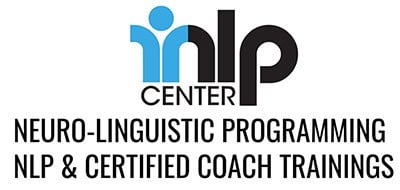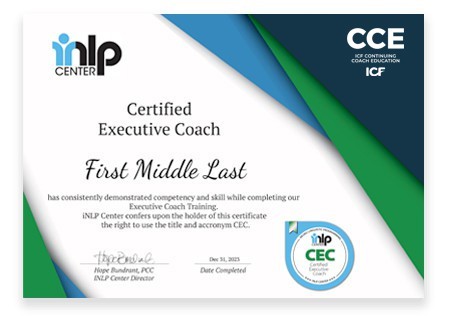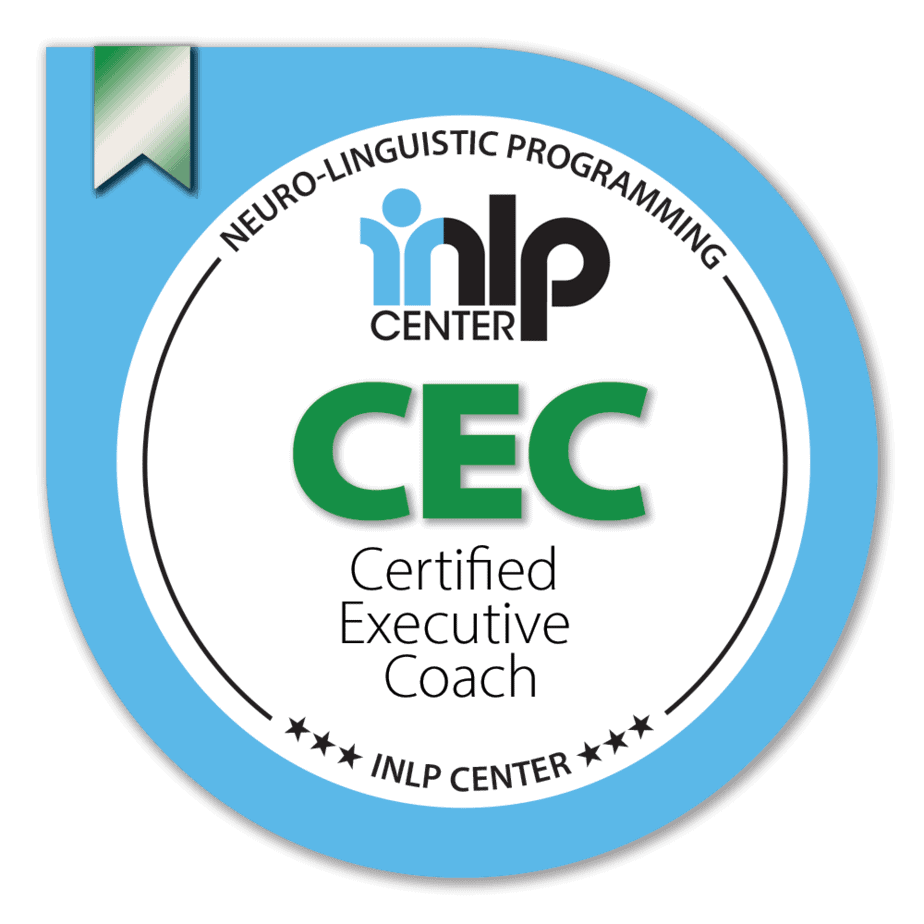Become a Certified Executive Coach and Get the Tools You Need to Empower Leaders to Excel
As an executive coach, you’ll guide leaders to reach their full potential. You’ll help them sharpen their leadership skills, communicate with clarity and influence, and boost their productivity. You’ll guide them to build unshakable confidence and find that perfect balance between work and personal life.
Ready to start your journey? Here’s what awaits you at the iNLP Center:
- 100% ICF Accredited and 100% Online
- 15 Modules & 149 Units
- 30-hour training (self-paced online coursework + live sessions)
- Unlimited Live Sessions in our Zoom Classrooms with your Trainer
- ICF Accredited for 24 CCE’s & 6 RD credit hours
- Access to your trainer for help and feedback on what you’re learning
- Study at your own pace and start right now
- Lifetime access to your learning material
- Created from 25 years of international NLP training experience
Discover A Unique and Proven Coaching Model for Executive Coaching
Our Executive Coach training explores the 3-part relationship of the Executive, the Team, and the Organization.
Using Neuro-Linguistic Programming (NLP) tools and coaching, you will support the executive client through their discovery of strengths, weaknesses, and most importantly solutions in their team, organization, and within themselves.
We teach an innovative framework called GAPS (Generated Areas for Purposeful Strategy), which encompasses the needs and goals of the executive, the team, and the organization. This model prepares you for the myriad of scenarios you will face with your clients.
Using GAPS, you will acquire a targeted perspective of where your client’s resources are and where they should be directed.
Our executive coaching certification training will challenge, stretch, and grow your coaching abilities to build competence and confidence.
Challenge and Foster Growth in the Following Areas
- Overview of Executive Coaching
- Impact Area Assessment Tool – MAP THE GAPS
- High-Level Communication Skills
- Company Culture of Learning & Personal Development
- Productivity, Output and Deliverables
- Congruence of Mission and Values
- Creativity and Problem Solving
- Goal Setting and Future Visioning
- Career Satisfaction and Support to Advance
- Leadership and Motivation
- Clarity of Objectives and Implementation
- Leveraging Strengths for Efficiency & Optimization
- Measuring Success
- Marketing Your Services as an Executive Coach
- Expansion Options for Impact
Executive Coaching Certification Training Modules
In addition to our NLP-integrated life coach training, you will also complete the modules below to earn your Executive Coaching Certification:

View breakdown of this module
| Module 1 | Overview of Executive Coaching | |
|---|---|---|
| Unit 1 | Course Overview | |
| Unit 2 | What is Executive Coaching? | |
| Unit 3 | The 3-Part Relationship | |
| Unit 4 | Reflection: 3-Part Relationships | |
| Unit 5 | Perceptual Positions in Executive Coaching | |
| Unit 6 | Goal Areas for Purposeful Strategy (GAPS) | |
| Unit 7 | GAPS in Detail |
Module 1: Overview of Executive Coaching
This module defines Executive Coaching and explains its importance and value in the professional world.
After completing this module, you will understand the 3-part relationship of the Executive, their teams, and their organization. You will learn the GAPS model for the training, which defines the Impact Areas for Success that you will explore with your Executive clients.

View breakdown of this module
| Module 2 | The Executive Coaching Process | |
|---|---|---|
| Unit 1 | Overview of the Executive Coaching Process | |
| Unit 2 | Ethical Conduct and Scope of Partnership | |
| Unit 3 | Impact Area Assessment Tool | |
| Unit 4 | • Coaching Exercise: Impact Area Assessment Tool | |
| Unit 5 | Information Gathering through Logical Levels Framework Questioning | |
| Unit 6 | • Psyche Builder : Logical Levels | |
| Unit 7 | Strategically using the Toward and Away Meta Program | |
| Unit 8 | Pre-Coaching Phase in Executive Coaching |
Module 2: The Executive Coaching Process
This module sets up the structure of the Executive Coaching sessions so that you and your Executive client have a clear path forward.
After completing this module, you will use the Universal Coaching Model to frame the sessions while adhering to ethical standards in the coaching relationship. You will learn how to use the Impact Area Assessment Tool to identify GAPS or Goal Areas for Purposeful Strategy. NLP strategies for information gathering, such as Logical Levels and the Toward and Away Meta Program, will be prioritized.

View breakdown of this module
| Module 3 | Communication | |
|---|---|---|
| Unit 1 | Communication Information Gathering | |
| Unit 2 | Impact Assessment Tool Questioning for Communication | |
| Unit 3 | Perceptual Positioning of the 3-Part Relationship Questioning for Communication | |
| Unit 4 | Meta Program of Toward and Away Questioning for Communication | |
| Unit 5 | Logical Levels Framework Questioning for Communication | |
| Unit 6 | Necessity Driving Questions for Communication | |
| Unit 7 | Communication Transformation Phase | |
| Unit 8 | Strategic Use of Chunking for Improving Communication | |
| Unit 9 | Chunking in Business Settings | |
| Unit 10 | • Stealth Mission: Chunking | |
| Unit 11 | Communication Integration Phase | |
| Unit 12 | Communication Wrap up and Homework Phase |
Module 3: Communication & the Coaching Process
The module explores the first Impact Area for Success from the GAPS Assessment, Communication, and the importance of effective internal and external communication for success.
After completing this module, you will know how to coach your Executive client on Communication. You will have learned multiple pathways for your client to gain insights about how their communication impacts their team and the entire organization. You will have learned how to use Chunking for improved business communication.

View breakdown of this module
| Module 4 | Company Culture of Learning and Personal Development | |
|---|---|---|
| Unit 1 | Learning and Development Information Gathering | |
| Unit 2 | Hard Skills and Soft Skills | |
| Unit 3 | Impact Assessment Tool Questioning for Learning and Development | |
| Unit 4 | 3-Part Relationship Questioning for Learning and Development | |
| Unit 5 | Meta Program of Toward and Away Questioning for Learning and Development | |
| Unit 6 | Logical Levels Framework Questioning for Learning and Development | |
| Unit 7 | Necessity Driving Questions for Learning and Development | |
| Unit 8 | Culture of Learning Transformation Phase | |
| Unit 9 | Negative Past versus Positive Future | |
| Unit 10 | VAK Questioning for New Possibilities | |
| Unit 11 | • Coaching Exercise: Negative Past vs Positive Future | |
| Unit 12 | Culture of Learning and Personal Development Integration Phase | |
| Unit 13 | Culture of Learning and Personal Development Wrap-up and Homework Phase |
Module 4: Company Culture of Learning & Personal Development
The module explores the second Impact Area for Success from the GAPS Assessment, Company Culture of Learning and Personal Development.
After completing this module, you will have learned about the impact of valuing continued education and development within an organization. You will have learned how to leverage the NLP strategy of Negative Past versus Positive Future to support your Executive client’s growth and transformation.

View breakdown of this module
| Module 5 | Productivity, Output and Deliverables | |
|---|---|---|
| Unit 1 | Productivity, Output and Deliverables Information Gathering | |
| Unit 2 | Impact Assessment Tool Questioning for Productivity | |
| Unit 3 | 3-Part Relationship Questioning for Productivity | |
| Unit 4 | Meta Program of Toward and Away Questioning for Productivity | |
| Unit 5 | Logical Levels Framework Questioning for Productivity | |
| Unit 6 | Necessity Driving Questions for Productivity | |
| Unit 7 | Productivity, Output and Deliverables Transformation Phase | |
| Unit 8 | Moving out of Stuck States | |
| Unit 9 | Resource Frames and Presuppositions | |
| Unit 10 | Possibility vs. Necessity | |
| Unit 11 | • Coaching Exercise: Sustaining a Successful Mindset | |
| Unit 12 | Productivity, Output and Deliverables Integration Phase | |
| Unit 13 | Productivity, Output and Deliverables Wrap up and Homework Phase |
Module 5: Productivity, Output and Deliverables
This module explores the third Impact Area for Success from the GAPS Assessment, Productivity, Output, and Deliverables.
After completing this module, you will have explored how productivity and measurable output can drive the emotional state of the Executive client, their team, and the organization. You will have learned how to identify stuck states of belief around productivity. You will have learned how to leverage Resource Frames to support your clients into a mindset of possibility around what can be produced or generated.

View breakdown of this module
| Module 6 | Congruence of Mission and Values | |
|---|---|---|
| Unit 1 | Congruence of Mission and Values Information Gathering | |
| Unit 2 | Impact Assessment Tool Questioning for Congruence | |
| Unit 3 | 3-Part Relationship Questioning for Congruence | |
| Unit 4 | Meta Program of Toward and Away Questioning for Congruence | |
| Unit 5 | Logical Levels Framework Questioning for Congruence | |
| Unit 6 | Necessity Driving Questions for Congruence | |
| Unit 7 | Congruence of Mission and Values Transformation Phase | |
| Unit 8 | Perceptual Positions | |
| Unit 9 | • Coaching Exercise: Congruency in Perceptual Positions | |
| Unit 10 | Congruence of Mission and Values Integration Phase | |
| Unit 11 | Congruence of Mission and Values Wrap up and Homework Phase |
Module 6: Congruence of Mission and Values
This module explores the fourth Impact Area for Success from the GAPS Assessment, Congruence of Mission and Values.
After completing this module, you will have a deeper awareness of how congruence or the lack of congruence to an organization’s mission and values influences the actions, beliefs, and behaviors of team members’ commitment. You will learn how to use Perceptual Positions to offer insight to an Executive client into how the level of congruence to the organizational mission can drive successful momentum within a team or can cause a team to rapidly reduce cohesion and effectiveness.

View breakdown of this module
| Module 7 | Goal Setting and Future Visioning | |
|---|---|---|
| Unit 1 | Goal Setting and Future Visioning Information Gathering | |
| Unit 2 | Impact Assessment Tool Questioning | |
| Unit 3 | 3-Part Relationship Questioning for Goal Setting and Future Visioning | |
| Unit 4 | Meta Program of Toward and Away Questioning | |
| Unit 5 | Logical Levels Framework Questioning for Goal Setting | |
| Unit 6 | Necessity Driving Questions for Goal Setting and Future Visioning | |
| Unit 7 | Goal Setting and Future Visioning Transformation Phase | |
| Unit 8 | Goal Setting and Future Visioning Integration Phase | |
| Unit 9 | Goal Setting and Future Visioning Wrap-Up and Homework Phase | |
| Unit 10 | • Coaching Exercise : Goal Setting |
Module 7: Goal Setting and Future Visioning
This module explores the fifth Impact Area for Success from the GAPS Assessment, Goal Setting, and Future Visioning.
After completing this module, you will understand the connection between the mindset of an Executive client and their capability to communicate the goals and vision of the organization to their team. You will learn how to use goal-focused communication to empower your client. You will also learn how to use NLP Goal Setting Guidelines to support your client’s goals and vision.

View breakdown of this module
| Module 8 | Creativity and Problem Solving | |
|---|---|---|
| Unit 1 | Creativity and Problem Solving Information Gathering | |
| Unit 2 | Impact Assessment Tool Questioning for Creativity and Problem Solving | |
| Unit 3 | 3-Part Relationship Questioning for Creativity and Problem Solving | |
| Unit 4 | Meta Program of Toward and Away Questioning for Problem Solving | |
| Unit 5 | Logical Levels Framework Questioning for Creativity and Problem Solving | |
| Unit 6 | Necessity Driving Questions for Creativity and Problem Solving | |
| Unit 7 | Creativity and Problem Solving Transformation Phase | |
| Unit 8 | The Inverse Problem-Solving Process | |
| Unit 9 | • Coaching Exercise: Inverse Problem Solving | |
| Unit 10 | Creativity and Problem Solving Integration Phase | |
| Unit 11 | Creativity and Problem Solving Wrap-up and Homework Phase |
Module 8: Creativity and Problem Solving
This module explores the sixth Impact Area for Success from the GAPS Assessment, Creativity and Problem Solving.
After completing this module, you will understand how the ability to creatively problem-solve, impacts every level of an organization. You will learn how to use Inverse Problem-Solving as a strategy to support your client in their solution-finding. You will learn how to engage your clients to discover creative solutions they may have been previously unaware of.

View breakdown of this module
| Module 9 | Career Satisfaction and Support to Advance | |
|---|---|---|
| Unit 1 | Career Satisfaction and Support to Advance Information Gathering | |
| Unit 2 | Impact Assessment Tool Questioning for Career Satisfaction | |
| Unit 3 | 3-Part Relationship Questioning for Career Satisfaction | |
| Unit 4 | Meta Program of Toward and Away Questioning for Career Satisfaction | |
| Unit 5 | Logical Levels Framework Questioning for Career Satisfaction | |
| Unit 6 | Necessity Driving Questions for Career Satisfaction | |
| Unit 7 | Career Satisfaction and Support to Advance Transformation Phase | |
| Unit 8 | • Coaching Exercise: Career Satisfaction | |
| Unit 9 | Career Satisfaction and Support to Advance Integration Phase | |
| Unit 10 | Career Satisfaction Wrap-up and Homework Phase |
Module 9 – Career Satisfaction and Support to Advance
This module explores the seventh Impact Area for Success from the GAPS Assessment, Career Satisfaction, and Support to Advance.
After completing this module, you will recognize the level of influence that an Executive has on the morale and career satisfaction of an organization’s team members. You will learn how to use the NLP 12 States of Attention framework to bring insight to an Executive client on how their team views their future in the organization. You will explore what is possible for the organization as a whole when its environment supports growth opportunities.

View breakdown of this module
| Module 10 | Leadership and Motivation | |
|---|---|---|
| Unit 1 | Leadership and Motivation Information Gathering | |
| Unit 2 | Impact Assessment Tool Questioning for Leadership and Motivation | |
| Unit 3 | 3-Part Relationship Questioning for Leadership and Motivation | |
| Unit 4 | Meta Program of Toward and Away Questioning for Leadership | |
| Unit 5 | Logical Levels Framework Questioning for Leadership | |
| Unit 6 | Necessity Driving Questions for Leadership and Motivation | |
| Unit 7 | Leadership and Motivation Transformation Phase | |
| Unit 8 | The States of Leadership | |
| Unit 9 | Options for Accessing States | |
| Unit 10 | • Coaching Exercise: States of Leadership | |
| Unit 11 | Leadership and Motivation Integration Phase | |
| Unit 12 | Leadership and Motivation Wrap up and Homework Phase |
Module 10 – Leadership and Motivation
This module explores the eighth Impact Area for Success from the GAPS Assessment, Leadership and Motivation.
After completing this module, you will have a deeper understanding of the distinctions between doing the leadership actions versus being and embodying the leader. You will learn about the States of Leadership and its effect on a team within an organization. You will learn how to empower your Executive client with multiple options to access their chosen state to lead and motivate others from.

View breakdown of this module
| Module 11 | Clarity of Objectives and Implementation | |
|---|---|---|
| Unit 1 | Clarity of Objectives and Implementation Information Gathering | |
| Unit 2 | Impact Assessment Tool Questioning for Implementation of Objectives | |
| Unit 3 | 3-Part Relationship Questioning for Implementation of Objectives | |
| Unit 4 | Meta Program of Toward and Away Questioning for Implementation | |
| Unit 5 | Logical Levels Framework Questioning for Optimization | |
| Unit 6 | Necessity Driving Questions for Implementation of Objectives | |
| Unit 7 | Using Timeline to Influence Future for Strategic Implementation | |
| Unit 8 | Steps to Elicit Timeline to Influence to Response to Future Changes | |
| Unit 9 | • Coaching Exercise: Timeline to Influence Future Response for Change | |
| Unit 10 | Clarity of Objectives and Implementation Integration Phase | |
| Unit 11 | Wrap-up and Homework Phase for Implementation |
Module 11 – Clarity of Objectives and Implementation
This module explores the ninth Impact Area for Success from the GAPS Assessment, Clarity of Objectives, and Implementation.
After completing this module, you will have an expanded awareness of how flexibility to pivot when changes are happening in the marketplace is a valued skill of Executives. You will learn how to empower your Executive client to change plans of action when necessary to accomplish objectives. You will learn how to use Timeline to influence response to future potential change.

View breakdown of this module
| Module 12 | Leveraging Strengths for Efficiency and Optimization | |
|---|---|---|
| Unit 1 | Leveraging Strengths for Efficiency Information Gathering | |
| Unit 2 | Impact Assessment Tool Questioning for Leveraging Strengths | |
| Unit 3 | 3-Part Relationship Questioning for Leveraging Strengths | |
| Unit 4 | Meta Program of Toward and Away Questioning for Efficiency | |
| Unit 5 | Logical Levels Framework Questioning for Optimization | |
| Unit 6 | Necessity Driving Questions for Leveraging Strengths | |
| Unit 7 | Leveraging Inner Strengths for Transformation | |
| Unit 8 | Self-Anchoring | |
| Unit 9 | Self-Anchoring Steps | |
| Unit 10 | • Coaching Exercise: Self-Anchoring | |
| Unit 11 | Strength Optimization Integration Phase | |
| Unit 12 | Strength Optimization Wrap-up and Homework Phase |
Module 12 – Leveraging Strengths for Efficiency and Optimization
This module explores the tenth and final Impact Area for Success from the GAPS Assessment, Leveraging Strengths for Efficiency and Optimization.
After completing this module, you will recognize the opportunities that exist across the spectrum of an organization to increase efficiency, when strengths are leveraged from every team member by the Executive. You will learn how to support your Executive client, to connect to their inner strengths and resources. You will also learn how to empower your client with Self-Anchoring techniques to serve them in the future to leverage their strengths.

View breakdown of this module
| Module 13 | Measuring Success | |
|---|---|---|
| Unit 1 | The Importance of Offering a Growth Perspective | |
| Unit 2 | Re-Assessment for Measuring Success | |
| Unit 3 | Coaching for Progress Perspective Information Gathering after a 30-point Perspective | |
| Unit 4 | Information Gathering after a 30-point Perspective | |
| Unit 5 | Outcome Specification for Transformation | |
| Unit 6 | • Coaching Exercise: Outcome Specification | |
| Unit 7 | Integration of Learnings | |
| Unit 8 | Wrap-up with Establishing the Commitment for Moving Forward |
Module 13 – Measuring Success
This module explores measuring the progress of the coaching journey with the Executive client with the use of the Area of Impact Assessment Tool.
After completing the module, you will understand the value to an Executive client or their sponsoring organization, of identifying measurements of growth. You will learn how to use the assessment tool to map out focused action for the Executive client to prioritize in the future. You will learn how to leverage the results of the reassessment to celebrate your client’s internal and external growth.

View breakdown of this module
| Module 14 | Expansion Options for Impact | |
|---|---|---|
| Unit 1 | Leading the Way | |
| Unit 2 | Team Impact | |
| Unit 3 | Organization Impact | |
| Unit 4 | Industry Impact | |
| Unit 5 | Legacy Creating Contribution |
Module 14 – Expansion Options for Impact
This module highlights the options that are available for an Executive client to integrate what they’ve learned from their coaching journey by sharing their insights with others in their organization or industry.
After completing this module, you will have additional support options to continue your coaching relationship with your Executive client on a new level, if they choose to share their learning from the coaching journey. You will learn how to broaden their perspective. You will learn how to support your client in their efforts to have a deeper impact on their organization or their industry.

View breakdown of this module
| Module 15 | Marketing Your Services as an Executive Coach | |
|---|---|---|
| Unit 1 | The Options to Serve | |
| Unit 2 | External Coaching | |
| Unit 3 | Outlining Confidentiality | |
| Unit 4 | PR, Media, and Marketing | |
| Unit 5 | Leveraging Outcomes and Referral Business | |
| Unit 6 | YAY! Request your Certified Executive Coach Certificate! |
Module 15 – Marketing Your Services as an Executive Coach
This module outlines the multiple avenues that an Executive coach can serve, both internally for an organization or externally.
After completing this module you will have a broader perspective of opportunities that exist for Executive coaches. You will learn the advantages of serving as an internal or external coach. You will learn how to outline confidentiality with your Executive clients and their sponsors. You will learn multiple ways to leverage media and outreach efforts to build your brand as an Executive coach.
“A Game-Changer for Anyone Working in a Corporate Environment”
“While working in HR, I spend much time coaching managers and counseling employees. I knew I needed more than the life coaching certification to be fully effective in a corporate environment to assist the executives and managers. The Executive Coaching training is an excellent supplement to the life coaching certification. The program levels up where the life coaching leaves off and provides a valuable assessment tool that shows the impact in ten different key areas of leadership that impact performance and employee engagement on a team and the organization. This program is a game-changer for anyone who is currently working in a corporate environment or intends to in the near future.”
– Teri C.
Executive Coaching Certification Training Tracks
| Coach Training Program: | Program Includes: | One-time Price | Installment Plan |
|---|---|---|---|
| Executive Coaching Certification Track – ICF Level 2 4 Certifications | • NLP-Integrated Master Coach Training (ICF Level 2) • Executive Coaching Training (ICF Accredited) • Business & Marketing Guide • ICF Mentor Coaching | $7400 Enroll Now | $775/mo. for 10 months Enroll Now |
| Executive Coaching Certification Track – ICF Level 1 4 Certifications | • NLP-Integrated Life Coach Training (ICF Level 1) • Executive Coaching Training (ICF CCE’s) • Business & Marketing Guide • ICF Mentor Coaching | $5600 Enroll Now | $653/mo. for 9 months Enroll Now |
| Executive Coaching Certification Condensed Track 3 Certifications | • NLP Combo Training (ICF CCE’s) • Executive Coaching Training (ICF CCE’s) See Prerequisites below* | $2800 Enroll Now | $592/mo. for 5 months Enroll Now |
| Executive Coach Training Add-on 1 Certification | • Executive Coaching Training Only (ICF CCE’s) See Prerequisites below** | $2000 Enroll Now | – |
Executive Coach Training FAQ’s
In order to work as an executive coach, one should complete a training that provides an Executive Coach Certification. An executive coach training should include the ICF core competencies and NLP training. This combination of executive coach training content will prepare someone to work with executive coach clients.
To qualify as an executive coach you should complete an ICF accredited coach training and an executive coach specialty training. Our Executive Coach Certification Track, above, will provide everything you’ll need to qualify.
To become an ICF executive coach you will first need to complete an accredited ICF coach training and executive coach training, such as our Executive Coaching Certification Track (find that above). This will provide the requirements for both the ICF ACC coach credential and your Executive Coach certification.




